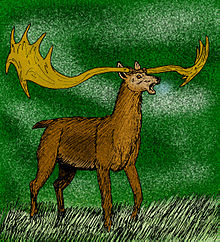Libralces
| Libralces Temporal range: Pliocene-Pleistocene
| |
|---|---|

| |
| Libralces gallicus | |
| Scientific classification | |
| Domain: | Eukaryota |
| Kingdom: | Animalia |
| Phylum: | Chordata |
| Class: | Mammalia |
| Order: | Artiodactyla |
| Family: | Cervidae |
| Subfamily: | Capreolinae |
| Tribe: | Alceini |
| Genus: | †Libralces Azzaroli 1952[1] |
| Species | |
| |
Libralces was a genus of Eurasian deer that lived during the Pliocene epoch. Its main claim to fame are its 2+ meter wide antlers, comparable in size to those of Megaloceros.
Libralces fossils have been found from France to Tajikistan,[1] with the best-known examples being the French L. gallicus.
According to Jordi Agustí, Libralces was the ancestor of Megaloceros, though most other authorities regard it as a relative of moose, Alces.
In the Pleistocene, there were three genera of Holarctic moose-like deer — Cervalces, Alces, and Libralces. In contrast to modern Alces, the Villafranchian Libralces gallicus had very long-beamed, small-palmed antlers and a generalized skull with moderately reduced nasals; the Nearctic Cervalces had longer nasals and more complex antlers than Libralces. Azzaroli 1953 added Alces latiforns to Libralces, but this position has been challenged.[2]
Gallery
References
- ^ a b "Libralces". Paleobiology Database. Retrieved 16 September 2012.
- ^ Kurtén, Björn; Anderson, Elaine (1980). Pleistocene Mammals of North America. Columbia University Press. p. 315. ISBN 9780231037334.


